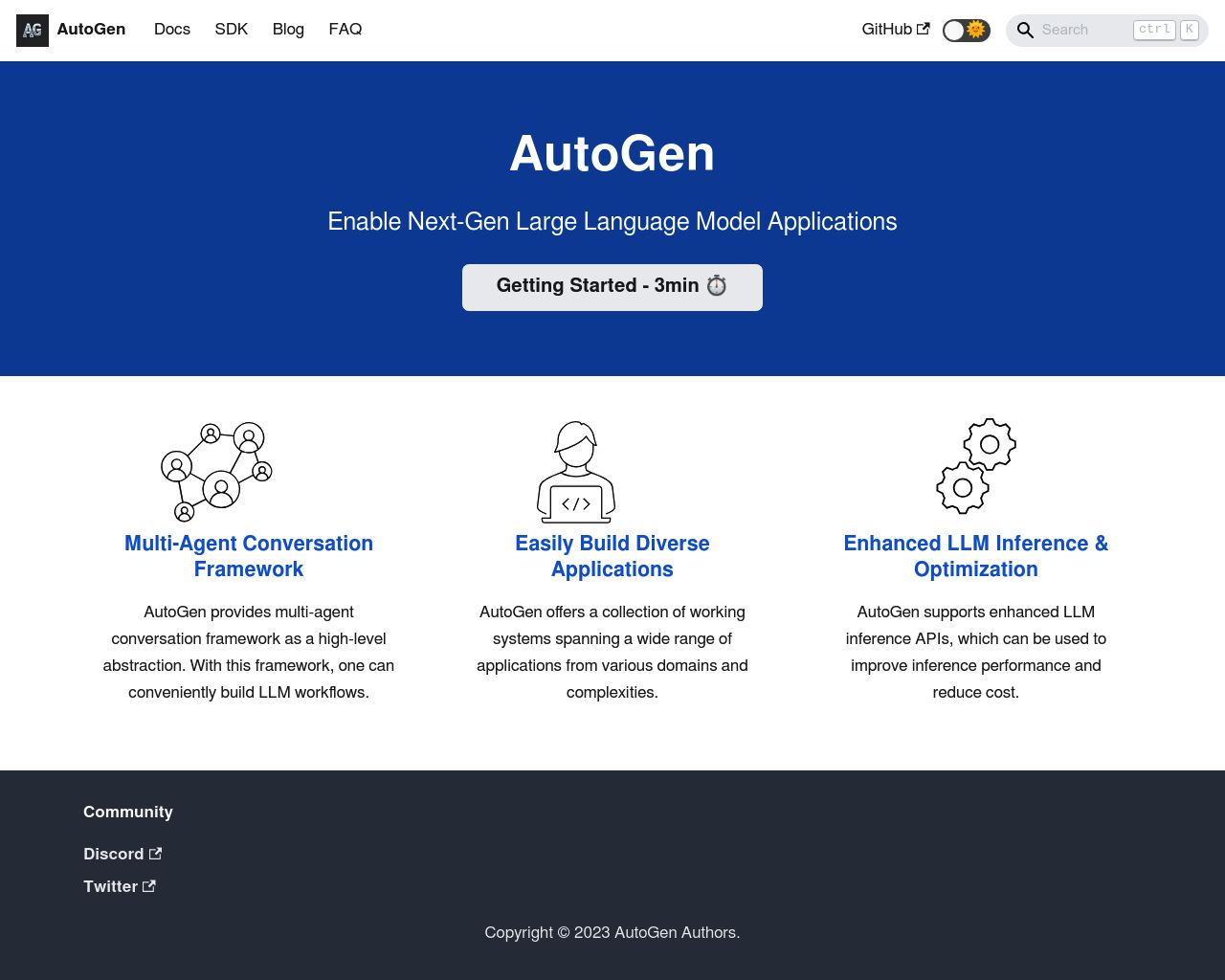AutoGen vs. Magic Loops: AI Agent Platforms Compared
AI agent development platforms revolutionize how businesses harness artificial intelligence, but choosing the right solution can be challenging. This comparison explores AutoGen vs. Magic Loops, and SmythOS, three powerful platforms reshaping the AI landscape. AutoGen offers sophisticated multi-agent collaboration for developers, while Magic Loops transforms natural language into automated workflows.
SmythOS emerges as a comprehensive solution, bridging technical prowess with user-friendly design. We’ll examine each platform’s strengths, limitations, and unique features to help you make an informed decision for your AI development needs. Whether you’re a seasoned developer, a business leader, or an AI enthusiast, this guide will illuminate the path to selecting the ideal AI agent platform for your projects.
AutoGen Overview
AutoGen revolutionizes AI development with its open-source framework for creating sophisticated Large Language Model (LLM) applications. This platform empowers developers to build multi-agent systems that collaborate autonomously or with human input, solving complex tasks across various domains.


AutoGen’s core strength lies in its multi-agent conversation capabilities. Developers can craft customizable, conversable agents that interact with each other, LLMs, tools, and humans. This flexibility enables the creation of AI systems tailored to specific tasks, from code generation to complex problem-solving in group chats.
AutoGen’s core strength lies in its multi-agent conversation capabilities. Developers can craft customizable, conversable agents that interact with each other, LLMs, tools, and humans.
The framework maximizes LLM performance through enhanced inference features like tuning, caching, and error handling. AutoGen supports both fully autonomous operations and human-in-the-loop scenarios, adapting to various application needs. Its versatility extends to debugging tools and logging functionalities, essential for optimizing LLM-based systems.
While AutoGen offers powerful capabilities, it requires coding knowledge for setup and lacks a visual builder or no-code editor. This limitation may pose challenges for non-technical users seeking to leverage its advanced features. However, for developers and AI enthusiasts, AutoGen provides a robust platform to push the boundaries of conversational AI and LLM applications.
Magic Loops Overview
Magic Loops transforms natural language descriptions into automated workflows, bridging the gap between no-code tools and full programming environments. The platform empowers users to create ’loops’—combinations of code and AI blocks—that automate repetitive tasks without extensive coding knowledge.


Magic Loops transforms natural language descriptions into automated workflows, bridging the gap between no-code tools and full programming environments.
Magic Loops excels in flexibility and integration capabilities. Users can fine-tune their loops to meet specific needs, leveraging various APIs and large language models. This versatility makes Magic Loops suitable for a wide range of automation tasks, from simple notifications to complex AI-driven processes.
The platform’s community-driven approach stands out. Users can share their loops publicly or utilize existing ones, fostering collaboration and resource sharing. This feature accelerates development and encourages innovation across the user base. Additionally, Magic Loops’ plans to open-source their platform demonstrate a commitment to transparency and customization.
Magic Loops’ vision extends beyond mere task automation. The company aims to democratize programming, aspiring to increase the proportion of people who can code from 1 in 200 to 1 in 5. By leveraging state-of-the-art generative AI, Magic Loops strives to make programming accessible to a broader audience, potentially revolutionizing how we approach software development and automation.
Magic Loops’ vision extends beyond mere task automation. The company aims to democratize programming, aspiring to increase the proportion of people who can code from 1 in 200 to 1 in 5.
While Magic Loops offers powerful capabilities, it may present a learning curve for users completely new to programming concepts. The platform’s effectiveness heavily relies on the user’s ability to describe tasks accurately and understand the basics of workflow design. However, for those willing to invest time in learning the system, Magic Loops provides a unique blend of accessibility and power in the realm of AI-driven automation.
Feature Comparison
AutoGen and Magic Loops offer distinct approaches to AI agent development, with notable feature gaps in core components and security. AutoGen excels in multi-agent collaboration and customizable conversational agents, supporting both autonomous operations and human-in-the-loop scenarios. Its framework maximizes LLM performance through enhanced inference capabilities like tuning and caching. However, AutoGen lacks a visual builder or no-code editor, requiring coding knowledge for setup and customization.
Magic Loops, in contrast, focuses on transforming natural language descriptions into automated workflows. It bridges the gap between no-code tools and full programming environments, allowing users to create ’loops’ that combine code and AI blocks. Magic Loops emphasizes flexibility and integration capabilities, enabling users to fine-tune their loops and leverage various APIs and language models. Unlike AutoGen, Magic Loops offers a more accessible entry point for users with limited coding experience.
In terms of security, both platforms have gaps. While AutoGen supports OAuth authentication for API integrations, it lacks specific features for data encryption and IP control. Magic Loops similarly does not explicitly mention advanced security measures like constrained alignment or comprehensive data protection protocols. These gaps highlight potential areas for improvement in both platforms’ security offerings.
Feature Comparison Table
| AutoGen | Magic Loops | SmythOS | |
|---|---|---|---|
| CORE FEATURES | |||
| Hosted Agents (Dev, Production) | ✅ | ❌ | ✅ |
| Environments (Dev, Production) | ✅ | ❌ | ✅ |
| Visual Builder | ❌ | ❌ | ✅ |
| No-Code Options | ❌ | ✅ | ✅ |
| Autonomous Agents | ✅ | ❌ | ✅ |
| Multimodal | ✅ | ❌ | ✅ |
| Multi-Agent Collaboration | ✅ | ❌ | ✅ |
| Audit Logs for Analytics | ✅ | ❌ | ✅ |
| Work as Team | ✅ | ❌ | ✅ |
| Agent Work Scheduler | ❌ | ✅ | ✅ |
| SECURITY | |||
| Constrained Alignment | ❌ | ❌ | ✅ |
| Data Encryption | ✅ | ❌ | ✅ |
| OAuth | ✅ | ❌ | ✅ |
| IP Control | ❌ | ❌ | ✅ |
| COMPONENTS | |||
| Foundation AIs | ✅ | ❌ | ✅ |
| Huggingface AIs | ✅ | ❌ | ✅ |
| Zapier APIs | ✅ | ❌ | ✅ |
| Classifiers | ✅ | ❌ | ✅ |
| Data Lakes | ❌ | ❌ | ✅ |
| DEPLOYMENT OPTIONS (EMBODIMENTS) | |||
| Staging Domains | ❌ | ❌ | ✅ |
| Production Domains | ❌ | ❌ | ✅ |
| Deploy as Site Chat | ✅ | ❌ | ✅ |
| Deploy as Scheduled Agent | ❌ | ✅ | ✅ |
| Deploy as GPT | ✅ | ❌ | ✅ |
| DATA LAKE SUPPORT | |||
| Hosted Vector Database | ❌ | ✅ | ✅ |
| Sitemap Crawler | ❌ | ❌ | ✅ |
| YouTube Transcript Crawler | ❌ | ❌ | ✅ |
| URL Crawler | ✅ | ❌ | ✅ |
| PDF Support | ✅ | ❌ | ✅ |
| Word File Support | ✅ | ❌ | ✅ |
| TXT File Support | ✅ | ❌ | ✅ |
Best Alternative to AutoGen and Magic Loops
SmythOS redefines AI agent development with its comprehensive platform. We offer a robust solution that surpasses AutoGen and Magic Loops in ease of use, feature richness, and versatility.
Our drag-and-drop interface empowers users to create sophisticated AI agents without extensive coding knowledge. This visual approach streamlines development, making AI accessible to a broader audience while maintaining the depth required for complex projects.
Unlike AutoGen’s framework-centric approach or Magic Loops’ limited workflow automation, SmythOS provides a complete ecosystem for AI agent creation and deployment. We support a wide array of AI models, including those from OpenAI, Anthropic, and Hugging Face, giving users unparalleled flexibility in choosing the right AI foundation for their projects.
SmythOS provides a complete ecosystem for AI agent creation and deployment. We support a wide array of AI models… giving users unparalleled flexibility in choosing the right AI foundation for their projects.
SmythOS excels in multi-agent collaboration and autonomous operations, areas where Magic Loops falls short. Our platform enables teams of AI agents to work together seamlessly, tackling complex tasks with efficiency that surpasses human capabilities. This collaborative functionality, combined with our advanced scheduling and monitoring tools, ensures that AI agents operate intelligently and productively in the background.
Security and scalability set SmythOS apart from competitors. We offer robust data encryption, OAuth integration, and IP control features that AutoGen and Magic Loops lack. Our platform scales effortlessly to meet enterprise-level demands while maintaining performance and reliability. With SmythOS, users can deploy AI agents across various environments, from development to production, with confidence in their security and functionality.
Conclusion
AutoGen, Magic Loops, and SmythOS each offer unique approaches to AI agent development, but SmythOS emerges as the superior choice for businesses seeking comprehensive, user-friendly AI solutions. AutoGen excels in multi-agent collaboration and customizable conversational agents, while Magic Loops focuses on transforming natural language into automated workflows. However, both platforms have limitations in visual building tools and security features.
SmythOS addresses these gaps and goes beyond, offering a powerful drag-and-drop interface that makes AI development accessible to both technical and non-technical users. Its extensive integration ecosystem, supporting over 300,000 integrations, provides unparalleled flexibility in connecting various data sources, APIs, and AI models. This versatility allows businesses to seamlessly incorporate AI into existing workflows across multiple platforms.
Unlike its competitors, SmythOS prioritizes security and scalability, featuring constrained alignment, data encryption, and OAuth support. The platform’s ’Create Once, Deploy Anywhere’ philosophy enables effortless deployment across various environments, from chatbots to APIs, ensuring that AI solutions can be easily integrated into any business process.
For those ready to experience the future of AI development, create a free SmythOS account today. Explore our diverse range of AI-powered agent templates to jumpstart your projects, and discover how SmythOS can revolutionize your approach to AI integration and automation. With SmythOS, you’re not just adopting an AI platform; you’re unlocking limitless possibilities for innovation and efficiency in your business.
Last updated:
Disclaimer: The information presented in this article is for general informational purposes only and is provided as is. While we strive to keep the content up-to-date and accurate, we make no representations or warranties of any kind, express or implied, about the completeness, accuracy, reliability, suitability, or availability of the information contained in this article.
Any reliance you place on such information is strictly at your own risk. We reserve the right to make additions, deletions, or modifications to the contents of this article at any time without prior notice.
In no event will we be liable for any loss or damage including without limitation, indirect or consequential loss or damage, or any loss or damage whatsoever arising from loss of data, profits, or any other loss not specified herein arising out of, or in connection with, the use of this article.
Despite our best efforts, this article may contain oversights, errors, or omissions. If you notice any inaccuracies or have concerns about the content, please report them through our content feedback form. Your input helps us maintain the quality and reliability of our information.
